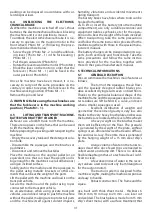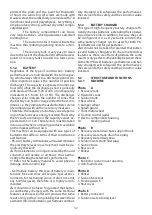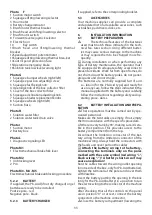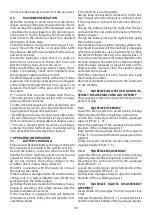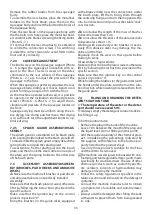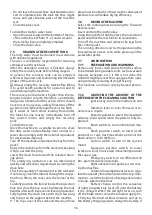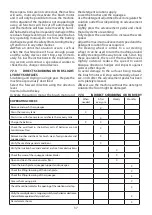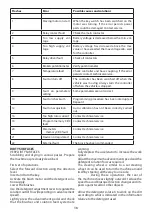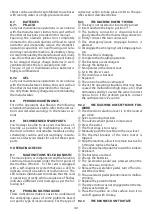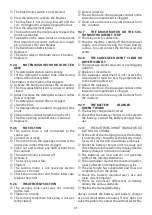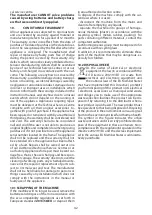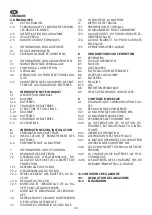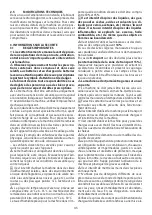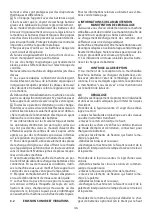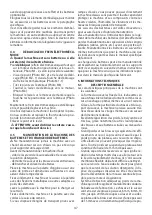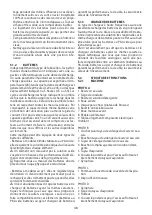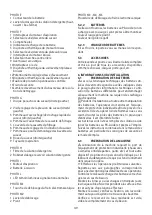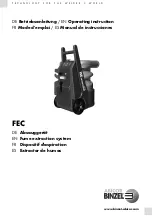
34
recovery tank) making sure not to crush any wires.
6.3
MACHINE PREPARATION
•
Before starting to work, wear non-slip shoes,
gloves and any other personal protection device
indicated by the supplier of the detergent used or
considered necessary based on the operating en-
vironment.
☞
Do the following before starting to
work. Refer to the relative sections for a detailed
description of these steps:
Check the battery charge level and charge, if nec-
essary. Mount the brushes or scraper disks (with
the abrasive disks) that are suitable for the surface
and work involved.
Mount the squeegee, check that it is solidly at-
tached and connected to the suction hose and
that the drying straps are not too worn.
Make sure that the recovery tank is empty. If not,
empty it completely. Check and completely close
the detergent solution release control.
Fill the detergent solution tank with a mix of clean
water and non-foaming detergent in an adequate
concentration through the rear hole. Leave 7 cm
between the mouth of the plug and the level of
the liquid.
☞
To avoid risks, become familiar with the ma-
chine movements, carrying out test runs on a large
surface without obstacles.
To obtain the best results in terms of cleaning and
equipment service life, you should do the follow-
ing simple but important operations:
- Identify the work area, moving all possible obsta-
cles out of the way; if the surface is very extensive,
work in contiguous and parallel rectangular areas.
- Choose a straight work trajectory and begin
working from the farthest area to avoid passing
over areas that have already been cleaned.
7. OPERATING INFORMATION
7.1
BATTERY CHARGING
Prepare and check the battery charge according to
the instructions provided in the specific section.
Detach the battery connector (the one with the
handle) from the machine power connector and
connect it to the battery charger connector.
•
Do not connect the battery charger to the
scrubber-drier’s main wiring connector.
Hold the connectors with the hands; do not pull
them using the cables.
If the machine is equipped with Pb-Acid batteries,
charge only in a well-ventilated area, lift the top
tank and open the battery plugs.
•
Follow the steps indicated in the battery manu-
facturer’s operating and safety manual (see the
battery maintenance section).
If the machine is equipped with gel batteries
(maintenance free), follow the instructions indi-
cated here below.
If the machine is used regularly:
Always keep the batteries connected to the bat-
tery charger when the machine is not being used.
If the machine is not used for extended time pe-
riods:
Charge the battery during the night after the last
work period, then disconnect the battery from the
battery charger.
Charge the battery during the night before using
the machine again.
Intermediate or incomplete charging while work-
ing should be avoided. If the machine is equipped
with Pb-Acid batteries, use a hydrometer to check
the element liquid intensity on a regular basis: if
one or more elements are discharged and the oth-
ers fully charged, the battery has been damaged
and should be replaced or repaired (refer to the
battery service manual). Close the element plugs
and lower the top tank.
Hold the connectors with the hands; don’t pull
them using the cables.
Reconnect the battery connector to the connector
on the machine.
7.2
SQUEEGEE AND SPLASH GUARD AS-
SEMBLY, DISASSEMBLY AND ADJUSTMENT
The squeegee is the main component that ensures
perfect drying.
7.2.1
SQUEEGEE ASSEMBLY
Lower the lifting system to avoid having to keep
the body raised while completing connections.
Loosen the connection knobs on the squeegee
support (Photo E - 3).
Insert the openings of the squeegee body in the
brackets of the oscillating support.
Fully tighten the squeegee knobs of the support
(Photo E - 3) in order to block the squeegee on the
support.
Firmly insert the machine suction hose into the
squeegee body (Photo E - 5).
7.2.2
SQUEEGEE DISASSEMBLY
Lower the lifting system to avoid having to keep
the body raised while completing connections.
Disconnect the suction hose from the squeegee
body (Photo E - 5).
Loosen the connections connection knobs on the
squeegee support (Photo E - 3).
Pull back the squeegee body to detach it from the
brackets of the oscillating support.
7.2.3 SQUEEGEE BLADES DISASSEMBLY/
ASSEMBLY
Disassemble the squeegee from its support (see
7.2.2)
Unscrew the knobs ( Photo G - 7 ), remove the bolts
and the metal bar holders of the squeegee blades.
Summary of Contents for 9070 0007
Page 3: ...3 1 2 A B 1 4 5 2 3 7 8 6 4 5 10 9 3 6 7...
Page 4: ...4 C 1 1 D 2 2 3 4...
Page 5: ...5 1 E 1 6 5 2 7 8 3 4 9 10 11 12 14 13 16 15 F 2...
Page 6: ...6 9 1 2 3 4 5 6 3 2 7 8 1 4 G H 1 2 7 8...
Page 7: ...7 L I 1 1 2...
Page 8: ...8 M1 M2 M3 1 2 1 2...
Page 9: ...9 M4 M5...
Page 92: ...92 8...
Page 93: ...93 7 3 12...
Page 94: ...94 6...
Page 95: ...95 5 2 10...
Page 96: ...96 4 4 35 10 50 30 95...
Page 97: ...97 3 5 1 CE CE 2 1 2...
Page 98: ...98 2 3 1 CE 4 1...
Page 99: ...99 1 1 1 1 1 2...
Page 101: ...101 2 2 1 2 2 2 10 2 3 2 4...
Page 102: ...102 2 5 3 3 1 4 35 C 10 50 C 30 95 2 10...
Page 103: ...103 3 2 96 4 4 1 4 2 4 3...
Page 104: ...104 4 4 Foto M1 2 M2 2 M2 1 M1 1 3 4 5 1 1 1 1 4 5 5 5 1 5 1 1...
Page 105: ...105 15 6 8 10 20 15 100 7 8 5 1 2 20 20 20h 5 5 5h 5 20 24 5 1 3...
Page 107: ...107 5 2 2 5 2 3 5 3 6 6 1 6 2 90 Anderson Anderson 0 6 3 7...
Page 108: ...108 7 7 1 7 2 7 2 1 E 3 E 3 E 5 7 2 2 E 5 E 3 7 2 3 7 2 2 G 7...
Page 109: ...109 G 7 7 2 4 G 6 G 2 45 G 6 G 2 7 2 5 7 3 1 1 7 4 50 C B 5 7...
Page 110: ...110 H 2 7 5 O 1 7 6 7 7 7 7 1 7 7 2...
Page 111: ...111 7 7 3 2 7 7 4...
Page 112: ...112 7 8 3 2 7 7 5 7 4 7 5 7 4 7 5 8 8 1 50 8 2 8 3...
Page 113: ...113 8 4 8 5 8 6 9 X X X X X X X X X X X X X X X X X X...
Page 114: ...114 8 7 8 7 1 1 2 3 4 5 6 7 8 9 10 12 16 19 20 21 22...
Page 115: ...115 8 7 2 8 8 8 9 9 9 1 9 L 1 9 2 9 2 1 1 30 9 2 2 5 9 2 3...
Page 116: ...116 9 2 4 9 2 5 9 2 6 9 2 7 9 2 8 9 2 9 9 2 10 100 20 30...
Page 117: ...117 10 12 10 1 2013 56 EU 10 2 2012 19 EU 2012 19 EU...
Page 134: ......












